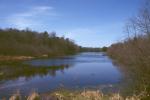|
Climate Change
Introduction
by John Young
The simplest definition of climate is the average of past weather conditions for a specific date. This is often referred to as “normal climate”. Since weather fluctuates over time spans from minutes to weeks, its statistical properties of variability may also be considered to be a part of climate. So, climate as a whole may be considered to be the distribution of probabilities of weather variables for a specific date. By definition, “normal seasonal climate” changes during the year.
In a given year, weather conditions which persistently deviate from “normal” climate values are termed “climate variability”. There are many such “natural cycles” which involve energy interactions between he global atmosphere, ocean, and land.. These cycles typically last months to years before reversing. Abnormally warm summers or El Niño anomalies are examples of natural cycles. They typically affect large regions (e.g., eastern North America), but not the entire globe.
When time periods extending to decades are considered, the presence of long-term trends in deviations from “normal” indicate “climate change”. This change is believed to be non-cyclic, a result of increased greenhouse gases caused by human activity starting in the 20th century. It can be thought of as a drift toward a “new normal” climate, which is warmer than the old normal climate at most locations on the globe.
In a changing climate, the probabilities of extreme events will
shift because of:
(a) a trend in "normal climate" (e.g. "climate warming"), (b) a
trend in climate variability (e.g. El Niño years), or (c) change
in weather types (e.g. cold surges diminishing). Climate change
science aims at understanding and predicting changes in the
probabilities of both "changing normals" and extreme events.
Research on changing climate impacts (e.g. WICCI) will follow
these steps:
(1) attribution of past climate/probability changes;
(2) assessment of predicted climate/probability changes;
(3) risk assessment of environmental vulnerabilities to changing extremes;
(4) policy guidance for adaptation in order to minimize future negative impacts.
Collaborations with Wisconsin Initiative on Climate
Change Impacts (WICCI)
research on climate impacts are now underway.
Statewide/Regional
- Please note: Graphs of
climate variables (such as temperature, precipitation)
for the past century are available for
Wisconsin's
climate divisions and six of its largest
cities.
- Midwest Regional Climate Center's Climate
Change & Variability in the Midwest
- A book entitled
"Understanding Climate Change: Climate Variability,
Predictability, and Change in the Midwestern United
States" has been recently published by Indiana
University Press describing contributions by climate
and other scientists to a workshop. Two chapters in
this book have been prepared by scientists with the
UW-Madison's Center for Climatic Research and the
State Climatology Office dealing with climate change
in Wisconsin.
- As part of the
"Global Climate Change Impacts in the United
States" report issued by the US Global Change Research
Program in June 2009 (see next section), a short
subsection
Regional Climate Impacts: Midwest (including
Wisconsin) is available as a 6-page pdf document.
- A report prepared by a group of scientists,
including Professor John Magnuson of the University of
Wisconsin-Madison, was released in 2003. The title of
this report is "Confronting Climate Change in the
Great Lakes Region: Impacts on Our Communities and
Ecosystems". If projections of increased warming are
correct, this report addresses the implications for
the Great
Lakes and Wisconsin.
- Shorter
river ice seasons confirm global warming - CNN
features UW-Madison research
National
- NOAA Climate Services Portal "Science & Information for a Climate-Smart Nation"
Topic Tabs: /News & Features, /Maps & Data, /Teaching Climate
at https://www.climate.gov/
- The American Meteorological Society (AMS) posted an Information Statement on Climate Change on 20 Aug 2012.
-
The U.S. Global Change Research Program released in
June 2009 a report entitled "Global Climate Change
Impacts in the United States"
For executive summary, regional results, and the full
report (a 196-page pdf file), go to the
website. This information is also available
on
Facebook and
Twitter.
- The US Climatic Change Science Program released in
March 2009 a 13-page guide called
Climate Literacy: The Essential Principles of Climate
designed
to help the public understand
the essential principles of climate sciences,
including how climate influences them and how they
influence climate.
- Historical trends for
seasonal temperature and precipitation across US
from Climate Prediction Center
-
National Climatic Data Center's Global
Climate Change
- The US Environmental Protection Agency (EPA) has
produced a module on its
Watershed Academy Web that considers "the effect
of climate change on water resources and programs."
- U.S. Department of State's
Bureau of International Information Programs recently
issued the following press releases as part of a series about necessary steps needed to address
the effects of climate change at regional and local
levels.
- The US Climatic Change Science Program has the
following series of "Synthesis and Assessment
S&A Products" including:
- "Climate Models: An Assessment of
Strengths and Limitations" (in July 2008) that describes
computer models created to simulate the Earth's
climate and their ability to model current climate
change. Press
release
- "Analyses of the effects of global change on
human health and welfare and human systems" (in July
2008) that discusses the potential impacts of
climate change on human health, human welfare, and
communities in the United States. Press
release
- "Weather and Climate Extremes in a Changing
Climate" (in June 2008) that provides a
comprehensive analysis of observed and projected
changes in weather and climate extremes across North
America and the US territories. Press
release
- Scientists at the National Climatic Data Center
recently announced that based upon their preliminary
analysis of available weather data for 2006, the just
completed year was the warmest nationwide since
relatively comprehensive records began in 1895. The
coterminous US annual average temperature was 55
degrees Fahrenheit, or 2.2 Fahrenheit degrees above
the 20th century long term average temperature and
0.07 Fahrenheit degrees above the previous highest
nationwide temperature set in 1998. [NOAA
News]
- NOAA issued its 2005 Annual Greenhouse Gas Index,
which is based upon benchmark measurements of
atmospheric gases that could affect the planetary
climate. For 2005, the index indicated an increase in
carbon dioxide and nitrous oxide, little change in
methane, and a decrease in two types of
chlorofluorocarbons. [NOAA
News]
- The US Climatic Change Science Program issued a
report in early May 2006 that is the first of 21
"Synthesis and Assessment S&A Products". This
first report entitled "Temperature Trends in the Lower
Atmosphere: Steps for Understanding and Reconciling
Differences" is meant to improve understanding of
atmospheric temperature change in the context of
global climate change and how humans have an influence
upon these temperature trends. [NOAA
News]
- NOAA working to improve understanding of climatic
change [NOAA
News]
- NOAA documents World's Oceans Warming over the
past 40 years [News
Release]
- American Association of State Climatologists' Policy
Statement on Climatic Variability and Change
- American Meteorological Society's Policy
Statements: On
Global Climate Change and Climate
Change Research: Issues for the Atmospheric and
Related Sciences
Global
-
The Intergovernmental Panel on Climate Change (IPCC)
Background -- The IPCC was established as a scientific intergovernmental body by the World Meteorological Organization (WMO) and by the United Nations Environment Programme (UNEP). to provide the decision-makers and others interested in climate change with an objective source of information concerning climate change.
Commencing in 1990 and into the latest cycle 2013/2014, the IPCC has produced five assessment reports (1990, 1995, 2001, 2007, and 2013/2014). Part 1 of the current Fifth Assessment Report, "The Physical Science Basis”, was released in September 2013. Parts 2-4 will appear in sequence starting in the first half of 2014.
The previous IPPC Fourth Assessment Report: Climate Change 2007 was presented in four parts from the four working groups:
- The previous Intergovernmental Panel on Climate Change IPCC 2007 Report, "The Physical Science Basis" was issued on 2 February 2007 that describes the latest on human-caused global warming and its future worsening. This most authoritative report is based on six years of new observations and analyses.
- A second part of the IPCC 2007 Report, " Impacts, Adaptation and Vulnerability" , was issued on 6 April 2007 that describes what the effects of the projected increases in global temperatures during the rest of the century would have upon societies, ecosystems, and the hydrologic cycle. Adaptation and vulnerability of these systems to climatic change are also addressed.
- The third part of the IPCC 2007 Report, entitled "Mitigation of Climate Change" was released on 4 May 2007 in Bangkok, Thailand. This part of the IPCC report focuses upon the scientific, technological, environmental, economic, and social aspects of mitigating projected climate change. It is intended as a summary for policy makers. Delegates contend that the technology and money are currently available for aggressive actions to limit emissions of greenhouse gases, improve fuel efficiency, and utilize renewable energy resources such as solar power in order to avoid some increases in global temperatures and associated climate-related disasters.
- The fourth and final part of the IPCC 2007 Report was issued in -November 2007 and called "Synthesis Report", serves as a scientific "instant guide" for policy makers.
Note: the entire current 2013/2014 IPCC 5th Report will be appearing on the IPCC site later in 2014. This report and the previous four IPCC Reports are also available from IPCC.
- Summer 2012 Arctic sea ice sets record low size - In August 2012, scientists from the National Snow and Ice Data Center report that areal extent of sea ice on Arctic Ocean was close to being the smallest since satellite surveillance began in 1979. NOAA ClimateWatch Magazine
-
2010 was one of two warmest in modern times --
Report from NOAA
- Lower Atmosphere is warming -- Scientists from NOAA, the NOAA-funded Cooperative Institute for Climate and Satellites (CICS), the United Kingdom Met Office, and United Kingdom's University of Reading, recently conducted a review of the history of understanding temperature changes and their causes in the scientific literature over the last four decades. These researchers found that the lowest 6 miles of the atmosphere (called the troposphere) has been warming and this warming has been generally consistent with both theoretical expectations and with climate models. NOAA News
- The American Meteorological Society's Information
Statement on Climate Change [4 pages] was issued
on 1 February 2007. This short report summarizes many
topics covered in the IPCC report, in a shorter text
and without figures.
- National Climatic Data Center's Global
Climate Change
- NOAA documents World's Oceans Warming over the
past 40 years [News
Release]
- Shorter
river ice seasons confirm global warming - CNN
features UW-Madison research
- Global
Change Master Directory (NASA)
- Climate
Variability and Climate Change - Global Hydrology
and Climate Center
- Goddard
Institute for Space Studies Datasets and
Images
- NOAA Annual Arctic Report Card A report of the state of the air, ocean and ice in the Arctic basin prepared by an international team and issued by NOAA's Climate Program Office. The 2012 annual update indicates that the region had above-average air and water temperatures in 2012, but nothing that was "remarkable" when compared with those over the last decade. However, record low amounts of Arctic snow cover were reported last June and the smallest areal coverage was found in summer Arctic sea ice in early September.
- Climate Change & Increasing Mediterranean Drought Frequency -- Wintertime droughts across the Mediterranean basin increased during the 20th century and computer models support the conclusion that climate change resulting from increased greenhouse gases have been a major factor.
- Global Sea Level Rise Scenarios for the United States National Climate Assessment
Report report published by NOAA's Climate Program Office indicates that scientists have a very high confidence (greater than 90% chance) that global mean sea level will rise at least 8 inches (0.2 meter) and no more than 6.6 feet (2.0 meters) by 2100.
General
Information
|
|
|
|
|

